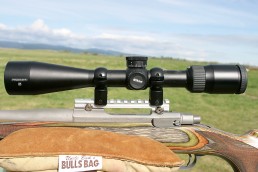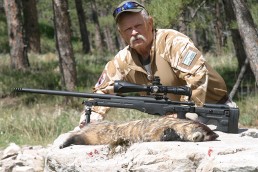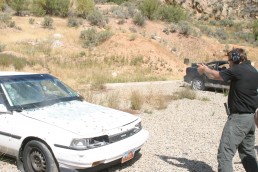A Current Rundown of Some Glass Sights part one
SHARE THIS POST
Sixteen days and 24 working hours of warm target shooting has shed some light on a few of the current new models in rifle scope design.
Nikon PROSTAFF
There is a trend in terms of observing a great deal of product offerings of rifle optics today. New scopes are coming out of the research and development stage with some major regularity. It is the intent here to take a short overview at several new models based on some real-time, hands-on live- fire testing.

First up is the new Nikon PROSTAFF scope that is a 4.5X18X50, first focal plain optic that makes use of the Nikon Custom XR Turret system. What this means is the Nikon will cut a custom turret based on your individual cartridges ballistics as a factory offering or a hand-loaded variant. As the scope comes from the manufacturer, it retains a general-purpose turret in MOA settings, such as a 100- yard zero is able to still turn up its elevation factory by a full 27.3 clicks.
Because I always take new optics into the field and test the real-time warm targets, I added a 20 MOA Weigand Combat Weaver-type rail to my Ruger Hawkeye. Weigand is one of the few companies that offer aftermarket flat or angled MOA rails for the Ruger-style receiver base mounts. This gives me a full 20 MOA elevation right from the get-go and then the remaining 24 MOA after zero is then added to the backside of this rail elevation system.
Based on the 130-grain Berger VLD bullet, just using the Weigand-angled base system gives the scope point-on-hit ability out to almost 800 yards prior to any required adjustments from the elevation clicks in again MOA graduations, re the turret knob. In effect, the total systems allows the Creedmoor coupled up to this scope the ability to send bullets well beyond 1,000 yards if enough altitude is in the equation to keep the bullet from going to sleep in flight.
If there is one element I did not like much regarding the reticle on the Nikon it was that the scope came for testing with a standard duplex-type crosshair—great for deer hunters, but not so much for long-range applications as in cutting down 600 or more yard prairie dogs.
With a 20 MOA base rail coupled with an 8 or 10 MOA reticle dot system, the shooter is good to 1,000 yards and never has to take his or her face out of the eyepiece during target searching and shooting. Nikon offers a BDC reticle for this system, if you request it. For the most part—as I have used both military and brand-generated systems—I would rather see a straightforward MOA dot (mil) system applied to this optic. It’s like this: Pal, just speak English and skip the fancy stuff—being everyone can count out an inch for elevation or impact change at 100 yards, and, multiply that number each 100 yards downrange for an exact impact elevation after a basic 100-yard zero as been produced.
As a scope sight that will retail for about $219, the final note regarding this PROSTAFF optic is that it is good value for the money. Light-gathering quality was good and the side-focus adjustments were crisp and effective well out to 600 yards during testing on prairie dogs. When used at Gun Sight in Arizona, the famous training facility, and applied to a Sisk Texas Star police sniper rifle, I stayed right with the big boys on the market in hot conditions that were flat out dreadful. The scope’s metal surface often jumped well above 130 F for long periods of time, and the element of dust and grit was ever-present. Based on this fact alone, you just can’t fault the scope as a survivor in any way. As a starter scope for long-range applications, or a deer hunter’s optic, the Nikon PROSTAFF is solid.
Tract riflescopes
Just in time for some early-season, prairie dog shooting, a new riflescope brand coming to the outdoor market labeled as “tract” riflescopes landed at my front door. What the scope is would suggest a project by the manufacturer that consists of using what they consider the “best” material designs in optic coatings, and blending this element into a tight package centering around a good medium-range big-game optic or varmint-hunting system. I was sent a sample scope labeled as a “Toric Ultra HD.” This scope makes use of a 3X15X42 mm objective lens and mounts a reticle design centering around the basic T-Plex-etched glass system. As indicated by the manufacturer, the Toric scope can also be obtained with the previously reviewed BDC Reticle as a second option. More on this element of the scopes design a bit later.
Making use of a 1-inch main tube and capped turret adjustments that appear to be 1/4 click per inch, adjusting bullet impact could be an issue for some shooters, as there were no directional marks on the prototype turret knobs. The turret housing on the Toric glass sight also retains the third adjustment for parallax/focus correction at given ranges. The focusing eyepiece (rear of scope) makes use of a full 4-inch eye relief, which will fight off “ring eye” from heavy magnum calibers. Magnification graduations from 3X-15X were selected for use in this optical system. Tract Optics built their scope in the first focal plane, which indicates that as magnification is increased or decreased, the crosshair or other reticule design will remain the same. Second focal plane scopes are the other primary design, and will change the size of those crosshairs as magnification changes.
Are you enjoying this post?
You can be among the first to get the latest info on where to go, what to use and how to use it!
Rifle
In terms of a test rifle, I elected to turn to the new Sisk Star custom-built 308 Win. These modular- style sniper rifles are handmade one at a time by Charlie Sisk. With such a tack hole driver out to its zero range—and based on my testing of the system at Gun sight in Arizona—it’s a solid MOA performer in law enforcement circles to any normal urban sniper range limit. Test ammunition for my fieldwork was all hand-loaded by me using the very new Sierra 168-grain Match King TMK bullets, Lake City U.S. Army “Match” cases, Federal LR primers and 43.3 grains of H-4895. Muzzle velocity on this load gave me a mild, but deadly accurate 2,600 fps round.
In the field
With the Tract scope mounted on a Sisk-built Weaver rail by way of heavy tactical-style rings, the system was taken out onto the test range for basic zeroing to 100 yards and a series of special optic tests so as to gain more information on basic functions of the new scope system. After bore sighting and shots sent downrange for zero, I shot a cross-shaped pattern consisting of 8 MOA elevation from zero by way of the scopes turret clicks. After recentering to zero (back to center,) eight more MOA clicks were turned to send bullets to the 6 o’clock position below the center zero point. Now with a second and third return to center, I then shot both left and right 8 MOA spreads.
At the completion of the test, the target returned a cross pattern, indicating that the scope was performing correctly and returning each time to the correct zero setting; no drift or failure to make corrections was noted. A point in fact is that even when basic zeroing, walking the bullet to dead on zero was only a three-round event after bore sighting the scope to the rifle. I would’ve liked to see marked up, down, right, left indicators on the turrets. I had time and no pressure to adjust my settings, turn everything around and have a 180 score whitetail standing at 450 yards, and, then try and remember which way to turn those elevation adjustments to bring a bullet into the kill ring.
As a second test, I selected a warm target (prairie dog) at a range of 300 yards, centered the
crosshairs on the target, adjusted the focus control by the knob on the left side of the turret and then increased the scope’s magnification from 6X to a full 15X. The observation was to see if the target blurred with a change in magnification. When reaching the 15X mark, it required a full one half turn on the parallax knob to bring the dog back into focus. This is a normal function, and there are few scopes under say, $1000 and change, that are so accurate in matching the focus knob to varied target ranges that the knob can in effect be used as a range finder of sorts in a pinch.
On target
With a one-stop shopping setup on our local test range—with having a square mile of dogs running among the steel targets—the transition from steel to dogs was instantaneous. The lens system as applied to this scope was clear to the edges and offered positive identification from young to old dogs quickly. With a week of rain and now high winds and clouds, shooting was less than great, but I did get enough rounds downrange so as to make an assessment as to the effectiveness of the optical system. My conclusion was that the scope sight returned good field results, but there were a few areas that need to be addressed. As live targets changed position and it was necessary to advance or retard range during the target acquisition, the duplex-style, very standard reticle was of no help and it required me to reach for the turret knobs and advance or retard clicks for changes in target range. What I feel would move this optic into a whole new ballgame would be the inclusion of a basic MOA reticle (military style) that makes for a game changer when rapid targeting is the order of the day. I realize the system makes use of a special order BDC reticle. And, as previously indicated, I know the system well. However, it is not an MOA search and destroy reticle by any means as it falls into line with one of many brand design reticles that are often slaves to one-cartridge load choice.
Couple the MOA reticle with the fact that this turret retains a full 45 MOA clicks beyond the basic 100-yard zero setting when pulling for ultra-long range elevation shots, this scope can turn into a mail-sending, long-range optic of the first order. The 308 Win is not a flat shooting cartridge, as I was required to hunt and peck using more round than necessary on warm targets from 300 to 500 yards. Also, with the scope using that first focal plane, it is a natural for MOA reticle applications.
Priced at the $400, I feel based on my short-term testing that this is value for the money, and with a few small changes, is a system that can push the ranging optics limits a good deal farther than it currently does.
L.P. Brezny has worked in research and development across the shooting industry for 37 years. He has developed and marketed systems for 12 gauges, designed ammunition for Winchester and Federal Cartridge, designed separator quiet slugs, shotshells and one-choke do-it-all systems. Brezny was the first ballistics writer to measure shotgun pellets in flight to ranges as great as 100 yards. He has published three books on shooting (Gun Digest Books), and is completing a fourth on long-range rifle applications. He has published hundreds of articles on sending rounds downrange.
MWO
SHARE THIS POST
Did you enjoy this post?
You can be among the first to get the latest info on where to go, what to use and how to use it!



